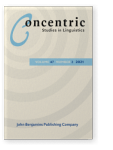Vol. 47:2 (2021) ► pp.167–183
Auditory startle disrupts speech coordination
Speech production requires temporal coordination between the actions of different functional groupings of muscles in the human body. Crucially, such functionally organized units, or “modules”, may be susceptible to disruption by an external stimulus such as a startling auditory stimulus (SAS; >120dB), enabling a possible window into the internal structure of learned speech movements. Following on the observation that SAS is known to accelerate the release of pre-planned actions, the current study examines lip kinematics in SAS-induced responses during speech movements to test whether this accelerated release applies on the scale of entire syllables or on the scale of smaller functional units. Production measures show that SAS-elicited bilabial movements in [ba] syllables are prone to disruption as measured by discontinuity in velocity profiles. We use a 3D finite element method (FEM) biomechanical model to simulate the temporal interaction between muscle groupings in speech. Simulation results indicate that this discontinuity can be accounted for as an instance of temporally decoupled coordination across neuromuscular modules. In such instances, the muscle groupings controlling lip compression and jaw opening, which normally fire sequentially, appear more likely to be activated synchronously.
Article outline
- 1.Introduction
- 2.Method
- 3.Results
- 4.Discussion
- Acknowledgement
- Notes
-
References
